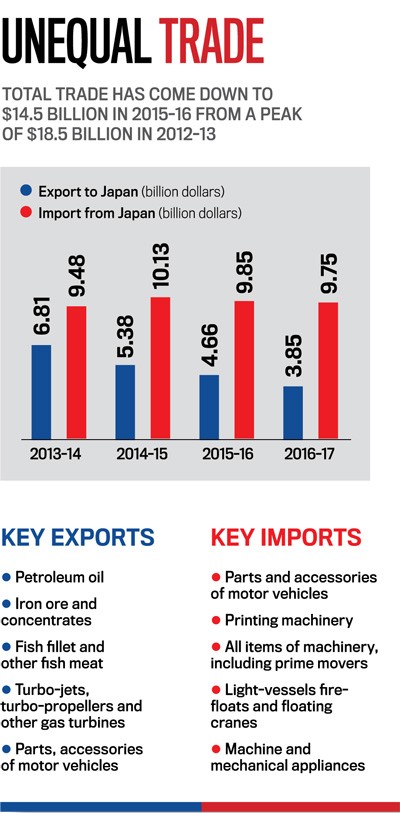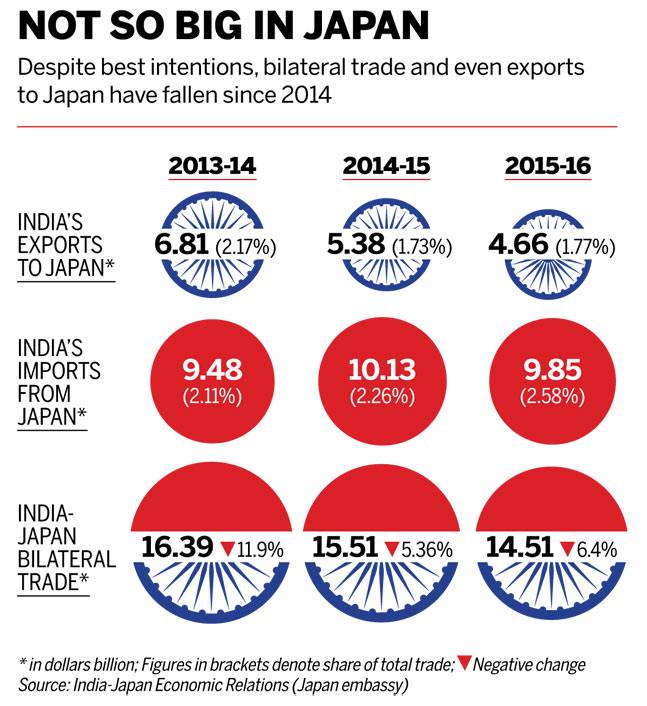Japan-India relations
This is a collection of articles archived for the excellence of their content. |
Ancient links
Kichijōji and other religious links
August 16, 2018: The Indian Express

From: August 16, 2018: The Indian Express
Takayuki Kitagawa, Consul General of Japan said that many might think Japan and India are different, though they are not. He cited the temples in Japan that are dedicated to Hindu gods as examples.
A town near Tokyo, Japan — Kichijōji — has been named after Hindu Goddess Lakshmi. The news was confirmed by Takayuki Kitagawa, Consul General of Japan, on Sunday according to a report in Indo-Asian News Service.
“You will be surprised to know that the town near Tokyo has its origin from Lakshmi temple. Kichijōji means Lakshmi temple in Japanese,” Kitagawa told students and faculty of Dayanand Sagar while speaking on their graduation day. Commenting upon the influence India had on the Japanese culture and society, Kitagawa said many think Japan and India are different, though they are not. He cited the temples in Japan that are dedicated to Hindu gods as examples.
“There are many more Hindu gods who are revered in the Land of the Rising Sun. For ages, we have been praying to Hindu gods,” said the diplomat. The audience were bowled over when he began his speech in Kannada.
Economic relations
Aftab Seth , Rising Suns “ India Today” 28/11/2016

Speaking at Japan's oldest university, Keio, in 1916, Rabindranath Tagore said the "whole of eastern Asia, from Burma to Japan, was united with India in the closest ties that can exist between nations". Prime Minister Narendra Modi's recently concluded visit to Japan is to be seen in this historical context and in the wake of a series of prime ministerial visits which, since 2005, have become an annual feature. The close economic cooperation between the two countries, especially the strategic and military dimension, dates to the historic visit of then Japanese PM Yoshiro Mori to India in August 2000, at the invitation of his counterpart here, A.B. Vajpayee. A 'Global partnership for India and Japan for the 21st century' was announced. Joint naval and coast guard exercises and annual meetings between the defence and foreign ministries and uniformed military officers of the two countries became a regular affair after this date. The partnership was elevated to a 'strategic and global partnership' in December 2006, when then PM Manmohan Singh signed an agreement to this effect in Tokyo with PM Shinzo Abe.
For the last five or more years, India and Japan have been in talks about civil nuclear cooperation. During Abe's visit to India in December 2015, the outlines of a civil nuclear agreement were finally agreed to, as also an agreement for the protection of classified military information and defence-related technologies. The agreement, signed by Abe and Modi in Tokyo on November 11, is a landmark for Japan, even though it has similar treaties for civil nuclear cooperation with 13 other countries. The significant point is this-it is the first such agreement Japan has signed with a country which is not a member of the Non-Proliferation Treaty (NPT). Japan is the only country in the world to have suffered atomic bombing. So there are deep concerns about nuclear matters and cooperation with a country which is not a signatory to the NPT. There is, in addition, a strong anti-nuclear movement in Japan comprising influential and vocal voices. The Abe government has overcome the domestic opposition with considerable effort by following the example of eight other nations, including France, the US and Russia, which have similar civil-nuclear agreements with India.
India's pledge to the Nuclear Suppliers Group (NSG) in 2008, to maintain its moratorium on further testing, provides Japan the domestic legitimacy it seeks in working with India. In the event of a breach, Japan has the right to sever the agreement with a year's notice. India is also committed to refraining from enriching uranium to 20 per cent or higher without Japan's written consent. Owing to supply chains with companies in Japan, France and the US, such as Toshiba, Hitachi, GE, Areva and Westinghouse, the recently-concluded agreement with Japan is most essential for the practical transfer of technology to India. The pact with India comes in the context of a recent decision by Vietnam to submit a resolution to cancel its proposed nuclear power station with Japan, owing to continuing safety concerns with the stricken nuclear power plant in Fukushima, which was struck by a triple tragedy on March 11, 2011. In any event, the agreement that Abe has pushed through with India represents a recognition of the reliability of India as a partner; it is also an expression of confidence and trust in India by Japan. This makes the pact truly unique. Japan has promised to continue its efforts to get India into the NSG and other related organisations, underlining its commitment to India's development of nuclear power. Business circles in Japan are optimistic that the agreement will lead to enhanced exports of equipment and machinery to India.
Other features of the Modi visit also bear mention. The first is the manner in which Pakistan has been singled out, in the paragraph on terrorism and cross-border support to terrorist activities. There is a clear reference to the need for Pakistan to pursue the culprits sheltering there who are responsible for the 26/11 attacks in Mumbai in 2008. India, it will be recalled, had been unable to get such an endorsement at the BRICS summit in Goa last month. The endorsement is symbolic of the distance Japan is willing to go in expressing its support to India unequivocally, on a matter which is of critical importance to India's security. The India and Japan Vision 2025 statement, announced on December 12, 2015, was mentioned again. This is significant because it underlines the commitment of both countries to democracy, an open society and firm opposition to all forms of terrorism. As was the case during Abe's 2015 visit, this time again there is a mention of the dangers posed by North Korea's nuclear and missile policies and its abduction of Japanese nationals. This is a most emotive issue in Japan and India's support on an issue of vital strategic importance to Japan is much appreciated here. In both 2015 and 2016, there is a clear reference to the South China Sea and the need for all countries to respect the UN Convention on the Law of the Sea.
Like so much else in the Japan-India strategic equation, the aggressive postures of China in the South China Sea, the Senkaku islands and in the Indian Ocean region, lie at the centre of much of the dialogue and indeed the conclusions of the two countries. The sale of US-2 (utility seaplane) amphibian aircraft was mentioned in the joint statement as a vital aspect of defence cooperation and it appears that further discussions on this will happen between the two defence establishments. An agreement, had it taken place, would have represented the first major export of defence material by Japan, after the changes made in Japanese laws governing such exports in the summer of 2015. Japanese assistance for Skill India and Make in India finds a place again in the 2016 document. Japan will continue to assist with the development of Japan industrial townships, promotion of tourism and in encouraging Indian students to spend time there.
During his 2007 visit to India, Prime Minister Abe outlined his vision of a 'Confluence of Two Seas' in Parliament. He stressed the indivisibility of the security of the Indian and Pacific Ocean regions. Earlier, in July 2005, then PM Manmohan Singh had reached a far-reaching defence agreement with then US president George W. Bush. This agreement, in the context of the 50-year security agreement that already existed between Japan and the US, provided the necessary legal framework for defence cooperation. It enabled trilateral naval exercises between Japan, India and the US off Okinawa, in April 2007. In September that year, the three countries were joined by the navies of Australia and Singapore. For a few years after these trilateral manifestations of cooperation, there was a gap in such activities (some analysts say this diffidence was caused by concern about China's views on Japan-India cooperation). With the advent to power of PM Modi in 2014, however, bilateral and trilateral exercises were resumed; in October 2015, Japan, the US and India held the Malabar naval exercises in the Indian Ocean. It may be noted that this enhanced level of strategic cooperation was specified in September 2014 during Modi's visit to Japan, when he and PM Abe raised the global and strategic partnership to a 'special' global and strategic partnership.
In December 2015, when they met in Delhi, the two leaders also agreed to cooperate in the development of connectivity between India and the ASEAN regions, where both India and Japan have important economic and strategic interests. Similarly, Japanese ODA (official development assistance) for the development of the Andaman Islands assumes strategic importance since the most remote of our islands is only 90 km from Sumatra, Indonesia. Progress on both the development of our Northeast region with road and rail links to Myanmar and beyond and the development of the Andaman islands was reviewed by the two sides at the November 11 meet in Tokyo. This cooperation in the Northeast with Myanmar as a focal point of entry to ASEAN needs to be viewed in the context of Aung San Suu Kyi's visit to Japan last week and the pledge given by Abe to grant $7.73 billion over five years to develop the country's infrastructure. PM Modi and Abe, in their recent talks in Tokyo on November 11 and 12, would doubtless have compared notes on Myanmar and ASEAN, a region where both Japan and India have deep strategic and economic interests and where both countries are seen as a counterweight to China's preponderance.
The successfully concluded Ahmedabad-Mumbai bullet train link assumes added significance in this Indo-Pacific partnership. These are modern manifestations of a history of shared values going back 15 centuries. They augur a bright future for our friendship.
The author, a former Indian ambassador to Tokyo, is chairman of the Japan-India Partnership Forum
